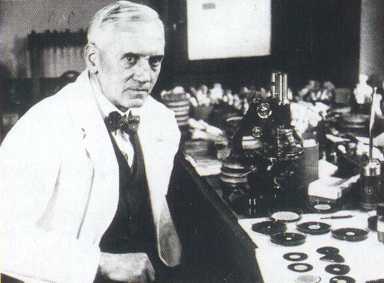 Almost so old, and gift in some civilizations, is the embolorado bread use and teias of spider in infectados wounds.
Almost so old, and gift in some civilizations, is the embolorado bread use and teias of spider in infectados wounds.Although the doctors have looked in the 2 a thousand following years a medicine species that fought the infection for bacteria, no researcher thought about scientifically investigating the medicinal folklore in relation to the bolores.
The first modern antibiotic, penicillin, was an accidental discovery of the Scottish bacteriologist Alexander Fleming, in 1928. Fleming had been a medical officer in the military hospitals of England during the World War I.
Noticing the serious necessity of an bactericidal agent to deal with the infectados wounds, after the war returned to the St. Mary's Hospital, in London, to search on the problem.
In 1928, while it studied the Staphylococcus aureus, a responsible bacterium for the abscesses and several other infections, Fleming entered of vacation per some days, leaving its glass containers with culture without supervision.
When returning, it noticed that the cover of one of the containers had slid and that the culture had been contaminated with the mildew of the atmosphere. Fleming was almost to lie down the culture outside when it made it to the curiosity to examine it. In the area where the bolor was to grow, the cells of the Staphylococcus had died.
It immediately perceived the meaning of this discovery and verified that the bolor, a species of fungo Penicillium, was to segregate a substance that destruía the bacteria.
Although it has not obtained to isolate the substance - what he was made ten years later for Ernst B. Chain and Howard W. Florey, in England -, it called it penicillin. Many scientists were skeptical how much to the potential of the bolor that had appeared by chance in the blade of Fleming.
They did not reveal made use to try in its patients a common bolor.
Other problems had resulted of the fragility of the bolor: it was weak, impure and easily destrutível for the climatic and acídicas changes.
Great amounts were necessary to get a enough penicillin concentration for an only patient, and Fleming did not have enough mounts of money.
With World War II it had a necessity of anti-septic fighting the infections of the wounded troops.
The Dr. Howard Walter Florey, professor of pathology in Oxford, had heard to speak on the bolor of Fleming and took the research ahead.
With one he equips of 20 scientists and technician, Florey cultivated the bolor of Fleming again.
During months he equips, it kept enormous large barrels of a embolorado and malcheiroso broth, trying to extract the main ingredient.
The Dr. Ernst Boris Chain obtained to extract of the solution a brown dust, that destroyed some bacteria instantaneously; in the truth, the extract contained only about 5% of penicillin in its pure chemical form.
The scientists had tested the substance in 80 different microbes; they had discovered that the fluids of the blood were not hostile to the substance and that the white globules were not damaged nor if they became inactive.
They had prepared a penicillin salt (I contend you leave sodium and calcium), that it was more steady of what the bolor, and well-had been occurred in the cure of rats that had received injections from aureus fatal doses of Staphylococcus, Streptococcus pyogenes, and other bacteria.
Its discoveries had formed the base for the treatment with penicillin that if practises until our days.
In 1940, penicillin was used, in England, in the first human patient, a policy with an advanced picture of sanguineous infection.
During five days the doctors had managed the drug to each two or three hours (penicillin leaves the body for piss quickly and, therefore, it must be restituted in frequent and regular intervals). The policy had recouped significantly when the penicillin suppliment if depleted and the injections had been suspended.
The infection spread and finished for winning it. The British scientists not yet had obtained to produce penicillin in amount enough to save a life.
In as in case that, however, a young, that also suffered with a sanguineous infection, received penicillin enough to recover.



1 comment:
Post a Comment
Note: Only a member of this blog may post a comment.